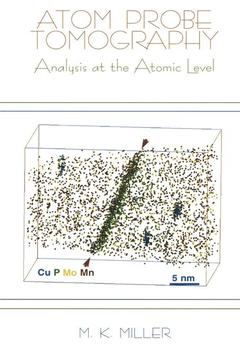Description
Atom Probe Tomography, Softcover reprint of the original 1st ed. 2000
Analysis at the Atomic Level
Author: Miller Michael K.
Language: English
Keywords
Metall; alloy; atom probe; atom probe tomography; field ion microscopy; metal; microscopy
Atom Probe Tomography
Publication date: 10-2012
239 p. · 17x24.4 cm · Paperback
Publication date: 10-2012
239 p. · 17x24.4 cm · Paperback
Approximative price 199.99 €
Subject to availability at the publisher.
Add to cart
Atom probe tomography: analysis at the atomic level
Publication date: 07-2000
234 p. · Hardback
Publication date: 07-2000
234 p. · Hardback
Description
/li>Contents
/li>
The microanalytical technique of atom probe tomography (APT) permits the spatial coordinates and elemental identities of the individual atoms within a small volume to be determined with near atomic resolution. Therefore, atom probe tomography provides a technique for acquiring atomic resolution three dimensional images of the solute distribution within the microstructures of materials. This monograph is designed to provide researchers and students the necessary information to plan and experimentally conduct an atom probe tomography experiment. The techniques required to visualize and to analyze the resulting three-dimensional data are also described. The monograph is organized into chapters each covering a specific aspect of the technique. The development of this powerful microanalytical technique from the origins offield ion microscopy in 1951, through the first three-dimensional atom probe prototype built in 1986 to today's commercial state-of-the-art three dimensional atom probe is documented in chapter 1. A general introduction to atom probe tomography is also presented in chapter 1. The various methods to fabricate suitable needle-shaped specimens are presented in chapter 2. The procedure to form field ion images of the needle-shaped specimen is described in chapter 3. In addition, the appearance of microstructural features and the information that may be estimated from field ion microscopy are summarized. A brief account of the theoretical basis for processes of field ionization and field evaporation is also included.
1 Overview and Historical Evolution.- 1.1 General Introduction.- 1.2 Evolution of the Three-dimensional Atom Probe.- 2 The Art of Specimen Preparation.- 2.1 Initial Preparation Methods.- 2.2 Thin Films.- 2.3 Electropolishing.- 2.4 Milling.- 2.5 Other Methods.- 2.6 Cleaning and Inspection.- 2.7 Prescreening in Transmission Electron Microscope.- 3 Field Ion Microscopy.- 3.1 Imaging Procedure.- 3.2 Field Ion Micrographs.- 3.3 Estimation of Parameters from Field Ion Images.- 3.4 Theoretical Background of Field Ion Microscopy.- 4 Instrumentation.- 4.1 Vacuum System.- 4.2 Field Ion Microscope.- 4.3 Mass Spectrometer.- 4.4 Instruments.- 5 Experimental Factors.- 5.1 Atom Probe Analysis Procedure.- 5.2 Volume of Analysis and Geometrical Considerations.- 5.3 Preferential Retention and Evaporation.- 5.4 Interpretation and Assignment of Ions.- 5.5 Reconstruction of Atom Positions.- 5.6 Detection Efficiency.- 5.7 Specimen Rupture or Failure.- 6 Data Representations and Analysis.- 6.1 Visualization and Analysis Methods for Individual Atoms.- 6.2. Smoothing Data.- 6.3 Data Representations.- 6.4 Composition Determinations.- 6.5 Estimation of Dimensions.- 6.6 Clustering and Ordering.- 6.7 Topological and Fractal Methods.- A. Reviews.- B. Phase Transformations.- C. Steels.- D. Superalloys.- E. Intermetallics.- F. Aluminum Alloys.- G. Multilayers and Films.- H. Miscellaneous Studies.- I. Other Sources of Reference to Atom Probe Studies.- Appendices.- A Formulae.- B Useful Constants and Conversions.- C Predictions of the Low Temperature Evaporation Field and Charge States for the Elements.- D Stereographic Projections.- E Percentage Points of the X2 Distribution.- F Periodic Table of Material Parameters.- G Periodic Table of Isotope Abundances.- Atom Probe Tomography.- Analysis at the Atomic Level.
© 2024 LAVOISIER S.A.S.




